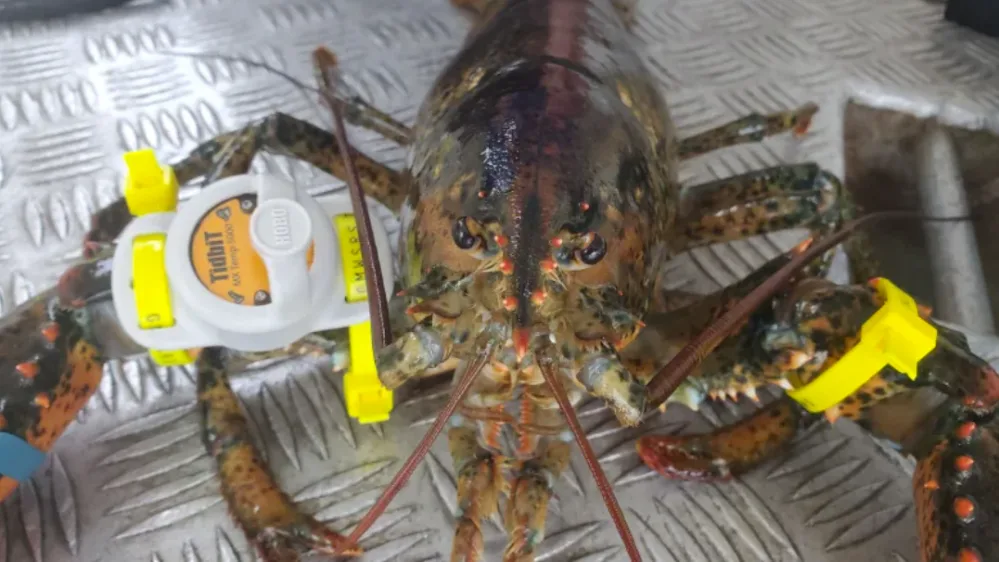
Tagging along on the secret life of the lobster
To the average consumer, a lobster is just a meal sitting on a plate waiting to be eaten.
Most have no idea that that meal has wandered hundreds of kilometres on the ocean floor before winding up on the menu.
But researchers who have been tagging the crustaceans know the average lobster in the Bay of Fundy can crisscross that bay several times over the course of a year.
A lobster caught on Grand Manan can easily make it's way to Nova Scotia in a month or two. Many go hundreds of kilometres further.
"Some of them go south to George's bank, some of them go over to Maine, and some of them go up the bay," said Heather Koopman, senior scientist at the Grand Manan whale and seabird research station. "I had one return last week from almost in Chignecto Bay."
Koopman has been studying marine species from the research station for 32 years. Originally from Ontario, she's the department chair of biology at marine biology at the University of North Carolina Wilmington, where she teaches. But during lobster season you're more likely to find her venturing out onto the open ocean with lobster boat crews.
As fishers bring the lobster aboard, she tags the females that must be released back into the ocean.
Some get a simple yellow zip-tie loosely placed around what is basically the lobster's wrist. On that plastic tag is an ID number and Koopman's phone number.

Koopman records lobster size and location before releasing the tagged lobster back into the Bay of Fundy. (Shane Fowler/CBC News)
"We just ask the fishers if they catch one these to text my phone, and the easiest way to do it is they snap a picture, because I want to know where they caught her, they snap a picture of their plotter which has the [longitude and latitudes] on it."
That gives researchers like Koopman a very rough idea of where the females are migrating over the course of a year. Depending on how many times a single lobster is caught and released, it can create a pretty accurate map showing about where it has been over the years.
And they don't move in a pack.
"Individual lobsters seem to make individual choices," said Koopman. "I can tag two lobsters in the same place on the same day, and they will be re-caught in totally different locations at different times. And so, it seems to be they have their own ideas about what they're going to do and where they're going to go."
SEE ALSO: Rare one in 100 million albino lobster discovered in Nova Scotia
Koopman says tagging lobster gives researchers an idea where egg-producing females are migrating, which could affect how lobster quotas and fishing zone boundaries are determined by the Department of Fisheries and Oceans.
But why do lobsters travel so far? That question may simply boil down to temperature.
Taking temperature
Some lucky lobster get a very different tag. Hobo Tidbits are thermal loggers that look like big yellow lobster wristwatches. Once they're activated, the gauges record the water temperature every 15 minutes.
When that lobster is caught again, and the logger brought back to Koopman, it connects via Bluetooth to an app on her phone and feeds her the exact temperatures that lobster has been exposed to since it was last picked up.

A clutch of lobster eggs stay attached to the underside of their mother's tail after they've been laid. (Shane Fowler/CBC News)
"Lobster reproduction is very sensitive to temperature, and lobsters themselves are very sensitive to temperature," said Koopman
"There's been some laboratory studies that have indicated that they can tell the difference, or they have a sensitivity, down to .1 degree Celcius. So, temperature makes a difference for lobsters."
Koopman says evidence points to lobster eggs requiring cooler temperatures when they're developing. But once those eggs are laid and stored underneath the female's tail, they likely require warmer temperatures to hatch at the right time.
"Water temperature accelerates metabolism, so if it warms up, everything happens faster. They deplete their yolk resources faster, they grow faster," said Koopman.

A Hobo Tidbit thermal logger is attached to a few lobster before they're released. The logger takes the temperature of the water every 15 minutes. (Shane Fowler/CBC News)
She says there's also evidence that newly hatched lobsters may feed on zooplankton, tiny aquatic organisms that are affected by temperature variation. So if the temperature isn't ideal when the eggs hatch, there may be no food around for them.
Koopman said the data gathered on those thermal loggers will go a long way to providing a window into the lobster's lifecycle in the wild, something she says scientists know precious little about. So far, there's not even a way to accurately gauge how old a lobster may be.
But another lobster tagger further up the Bay of Fundy is working on that.
Different tags
Koopman only gets about one in every four thermal loggers back and only 30 per cent of the yellow zip-ties. That's because when lobsters moult, they shed their entire exoskeleton, leaving those tags still attached to empty shells at the bottom of the ocean.
So how do you tag a creature that continuously sheds its skin, so to speak?
Rémy Rochette has spent the last 12 years researching lobsters from his lab at the University of New Brunswick in Saint John. Last spring he and his team tagged thousands of lobster in the Bay of Fundy with T-bar tags.
Rochette compares these tags to the tiny plastic tags that come on new clothes.
These ones pierce the lobster shell.
"Basically, they anchor in muscle tissue and when the lobster moults, it stays there, "said Rochette. "So, we can actually follow lobsters over longer time periods."
Rochette is trying out a technique that uses structural changes in DNA molecules to estimate age. He says a similar study was done in Europe on a different species, so his lab is testing to see if it will work on Homarus americanus — the American lobster found here on the Atlantic coast.
"When we [tagged] them, we also took a little biopsy and will use that little biopsy to look at … structural aspects of their DNA." aid Rochette. "So that'll be what the DNA looked like at that point in time, and then we're hoping to recapture those same lobsters, or some of them anyway, at different points in time."

T-bar tags allow researchers to tag lobster for longer as it doesn't come off during moulting. (Submitted by Rémy Rochette)
Out of the approximately 2,000 lobster Rochette and his team tagged this spring, 45 have been recaptured.
There is a more complex type of tagging and it doesn't require recapture.
These tags are attached to larger lobster shells using custom-made harnesses. Electronics in a tube record depth using pressure sensors, as well as recording temperature. When it comes time to collect the data, the tag is ejected from the tube and off the lobster.

Lobster fitted with custom satellite tags don't need to be recaptured in order retrieve the data collected. The tags are ejected from the harness, float to the surface, and transmit their data. (Submitted by Rémy Rochette)
"That has a little electronic mechanism that will trigger an explosion at a programmed set time that results in the tag releasing," said Rochette. "When they release, if all goes well, they come to the surface and they transmit the data back to us via satellite."
Proving them right
For all the technology and research involved in recording lobster movement and the temperatures they prefer, Koopman says lobster fishers already know much of what she's learning.

A lobster fitted with a custom harness and satellite tag as part of Rémy Rochette's research. (Submitted by Rémy Rochette)
"The people who are on the water everyday are the ones who know more about all of this than any of us," she said.
"They have been observing these things for years, for decades in some cases. Many of them have fished long enough to see big decadal fluctuations."

Data collected from tagged lobster give an idea of where they go after they've been released. (Submitted by Rémy Rochette)
Koopman says it's important to back up what fishers know with data, that in turn can lead to better fishing regulations to make it more sustainable in the years ahead. But she says it's always humbling working alongside those who have been making their living with lobsters their entire lives.
"What we do as scientists is sort of confirm what they've already hypothesized," said Koopman.
This article, written by Shane Fowler, was originally published by CBC News.









